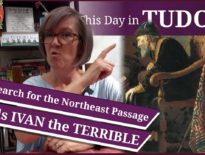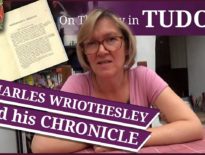On this day in history, in the Stuart period, 9th May 1657, William Bradford died. He is known as the founder of the Plymouth Colony in America and the writer of a chronicle of its early years: "“Of Plimmoth Plantation”.
But how did a Yorkshire man of farming stock become a Puritan and a governor of a colony in North America? What led to him becoming a "pilgrim" and boarding The Mayflower?
Find out in today's talk.
Bradford’s history of the Plymouth Plantation can be read online at - https://archive.org/details/historyplymouth00bradgoog/page/n11/mode/2up
Also on this day in history, 9th May 1509, the remains of King Henry VII were taken to St Paul’s to prepare for his burial at Westminster Abbey. Find out more in last year’s video:
And on this day in 1536, King Henry VIII wanted an update on the investigation into his second wife, Queen Anne Boleyn. Find out more in the video for 9th May 1536:
Also on this day in history:
- 1538 – Marie de Guise (Mary of Guise) and James V of Scotland were married by proxy at the Château de Châteaudun, with Robert Maxwell, 5th Lord Maxwell, standing in for James.
- 1558 – Death of Sir Philip Hoby, diplomat and administrator, at his home in Blackfriars, London. He had risen due to his friendship with Cromwell, and in Edward VI's reign, he was resident ambassador to the Emperor and a Privy Councillor.
- 1597 – Death of Thomas Hide, religious controversialist and writer of “A Consolatorie Epistle to the Afflicted Catholikes”. He fled into exile in Louvain in Elizabeth I's reign after he was labelled as a man who favoured the old religion. He then moved to Douai, where he died in 1597.
Transcript:
On this day in history, in the Stuart period, 9th May 1657, William Bradford died. He is known as the founder of the Plymouth Colony in America, and he was born in England in the reign of Queen Elizabeth I, hence my mention of him in these “on this day” talks.
Let me tell you a bit more about him…
• We don’t know his exact birthdate, but Bradford was baptised in Austerfield, in the West Riding of Yorkshire, on 19th March 1590, and baptisms usually took place within a few days of birth. He was the only son of William Bradford and his wife, Alice Hanson.
• During his early childhood, he lost his father, grandfather and mother, so was brought up by his paternal uncles, Robert and Thomas, who were farmers.
• Although there is no record of him attending university, he clearly had some education as he knew Latin, Greek, Dutch and French, and went on to learn Hebrew.
• During his youth, he was influenced by puritan ministers Richard Clyfton and John Robinson, and William Brewster, in whose home the Scrooby separatist puritan congregation Bradford was a part of met. Brewster and Bradford became good friends, with Brewster acting as his mentor.
• Things became difficult for the Scrooby congregation after the accession of King James I, who wanted to suppress the Puritan movement, and in 1607, members of the congregation were arrested. Some were imprisoned, and Brewster was fined. This, combined with the treatment of other puritans in England, led to the congregation making the decision to leave England for the Dutch Republic, where there was religious freedom due to a truce with Spain.
• Unfortunately, on their first attempt to cross to the Netherlands, they were betrayed by the ship’s captain, and Bradford was one of those who was imprisoned for a time. They then made a plan to split into groups to travel and by the summer of 1608 they had all reached Amsterdam.
• In 1609, they moved to Leiden, where Bradford lived with Brewster and his family, and worked as a fustian weaver. In 1613, he married sixteen-year-old Dorothy May, who came originally from Cambridgeshire, but whose family had settled in Amsterdam. They had their first child, John, in 1617.
• In 1611, when Bradford turned 21, he came into his inheritance and sold his property in England to buy a property in Leiden and invest in his business.
• 1621 was the year that the truce with Spain was due to expire, and there was concern among the separatists that their children were being negatively influenced by their Dutch neighbours, so in 1617, Bradford and other members of his church began to look into leaving the Netherlands and establishing a colony in North America.
• In 1619, Bradford sold his home and the would-be colonists arranged backing from English merchant adventurers.
• In July 1620, around fifty separatists, or “pilgrims” as Bradford called them, sailed from the Dutch port of Delftshaven on board the Speedwell, bound for Southampton. There, they met up with a bigger ship, the Mayflower, which, along with the Speedwell, as going to take the pilgrims across the Atlantic to North America. However, there were problems with the Speedwell, and the group eventually left aboard the Mayflower from Dartmouth on 6th September 1620. Bradford and Dorothy left their son, John behind, but he joined his father in America seven years later.
• On 11th November 1620, the Mayflower anchored at what is now Provincetown Harbor on Cape Cod, Massachusetts. On the same day, Bradford and forty other men signed the Mayflower Compact, the first governing document of the Plymouth Colony.
• Sadly, Bradford’s wife, Dorothy, drowned after falling overboard shortly after their arrival and while Bradford was off exploring the new land. On 15th December 1620, after explorations of the area, the Mayflower landed at Plymouth.
• The colonists were struck by a sickness their first winter and spring. Bradford was taken ill, but survived, but in April 1621 the colony’s first governor, John Carver died, and Bradford was chosen to replace him.
• The colonists were helped with their farming efforts by the local native American Indians, who also helped them with establishing relations with other Indian groups. Bradford’s biographer Sargent Bush Junior notes that Bradford “followed a policy of seeking peaceful relations with the neighbouring American Indians. Throughout his career he enforced a strict policy requiring that all land must be purchased before it could be settled.” When an Indian man was murdered in 1638, Bradford ensured that the three Englishmen responsible were tried and executed.
• In 1623, Bradford married his second wife, widow Alice Carpenter Southworth, who he’d known in Leiden and who he’d invited to join the colonists in Plymouth. They had two sons and a daughter.
• The colony put its trust in Isaac Allerton, whose in seeking personal profit brought the colony into debt, and Allerton had to be dismissed.
• Although in 1630, Bradford was named by patent as the colony’s owner, he signed his privileges away to all of the freemen of the colony.
• As well as being the founder of the Plymouth Colony, Bradford is also known for “Of Plimmoth Plantation”, his chronicle of the founding of the colony and its early years, which runs until 1646 and which is described by Sargent Bush Junior as the “fullest history of early American colonial experience”.
• William Bradford died on this day in history, 9th May 1657, in Plymouth, and was laid to rest on Burial Hill in Plymouth.



Leave a Reply